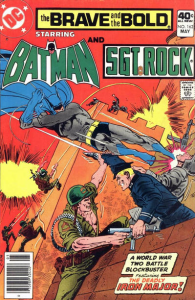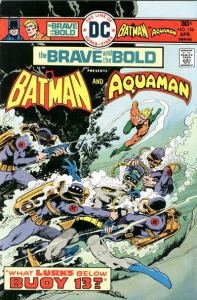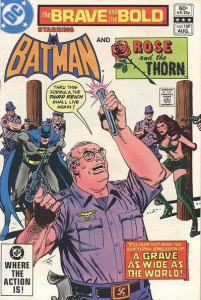Some people apply the label ‘fascist’ to a specific early 20th century ideology, and perhaps to some later derivative political projects. Others use the term more loosely, applying it to people who come across as authoritarian, unapologetically violent, and/or intolerant of different world views. For me, ‘fascist’ is what I call anyone who pisses me off. And you know who pisses me off? People who think they’re being clever when they call Batman a fascist.
I get it. There is something about a masked vigilante who resorts to torture and extrajudicial invasion of privacy that reflects totalitarian urges. Arguably, there is a fascist subtext inherent to superhero iconography in general, what with all the uniformed Übermenschen imposing order through brute force. But sticking this label on Batman still feels more like a superficial insult than a poignant analysis. I mean, the character himself is not supposed to be an actual fascist!
Except, you know, when he’s written by Frank Miller:
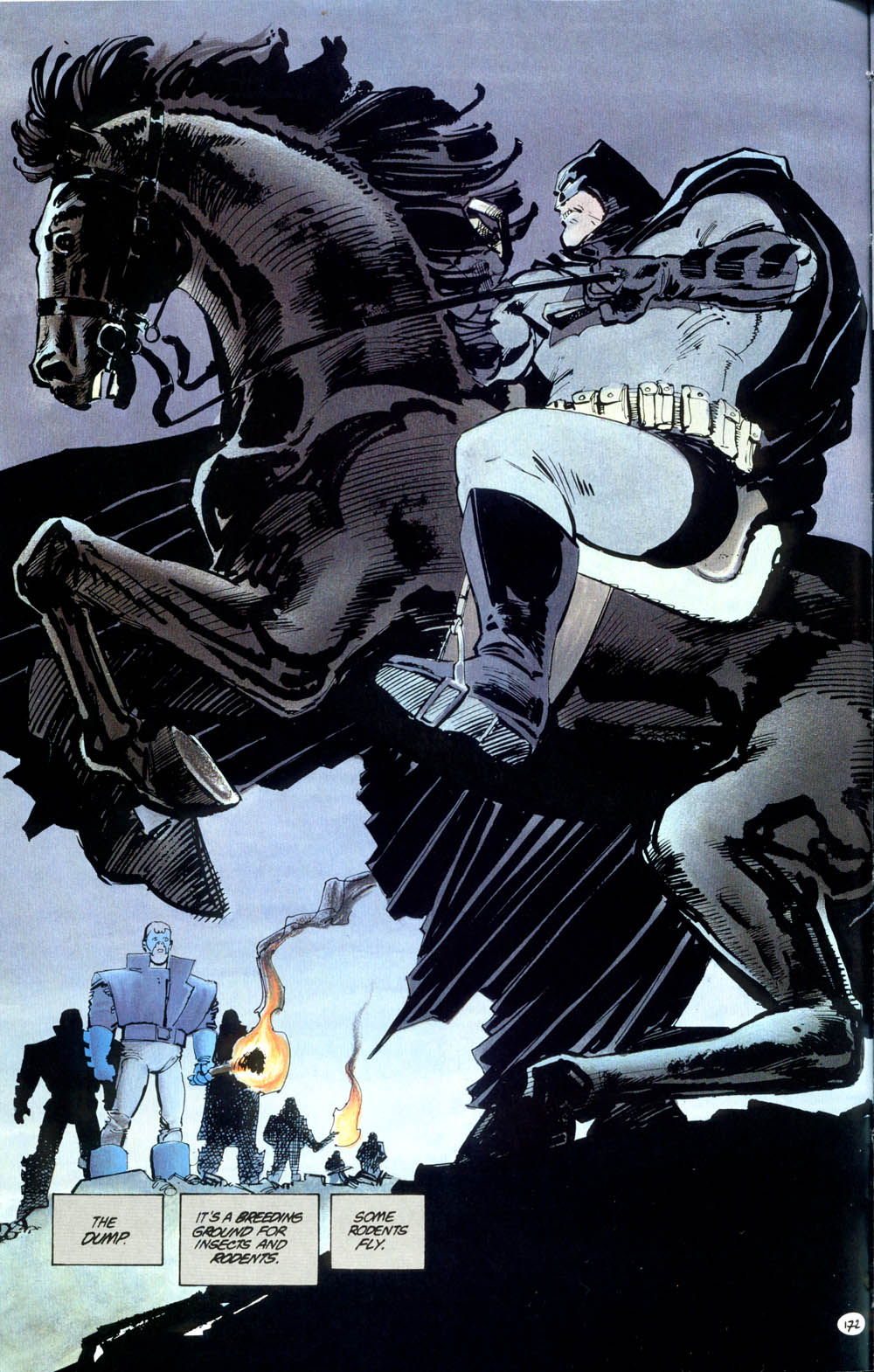 The Dark Knight Returns #4
The Dark Knight Returns #4
The Batman of Dark Knight Returns can be seen as ‘the worst sort of reactionary fascist,’ even if at one point he does fight an Arian woman with swastikas for nipples.
The thing about Miller’s take on Batman, though, is that this is not meant to be the familiar Caped Crusader, but rather a self-conscious twist on it. And once you start counting all the purposely alternative versions of the Dark Knight, then anything goes. For every story where Batman’s authoritarian tendencies take over (like Kingdom Come or the underrated ‘The Tyrant,’ in Shadow of the Bat Annual #2), there is an opposite comic with him as a committed anti-fascist. In ‘Berlin Batman,’ Paul Pope reimagines Bruce Wayne as Baruch Wane, a Jewish Dark Knight helping out oppositionists in 1938 Germany. In Howard Chaykin’s very cool Dark Allegiances, Batman is a plutocrat in the politically charged atmosphere of the Great Depression who goes up against homegrown American fascists.
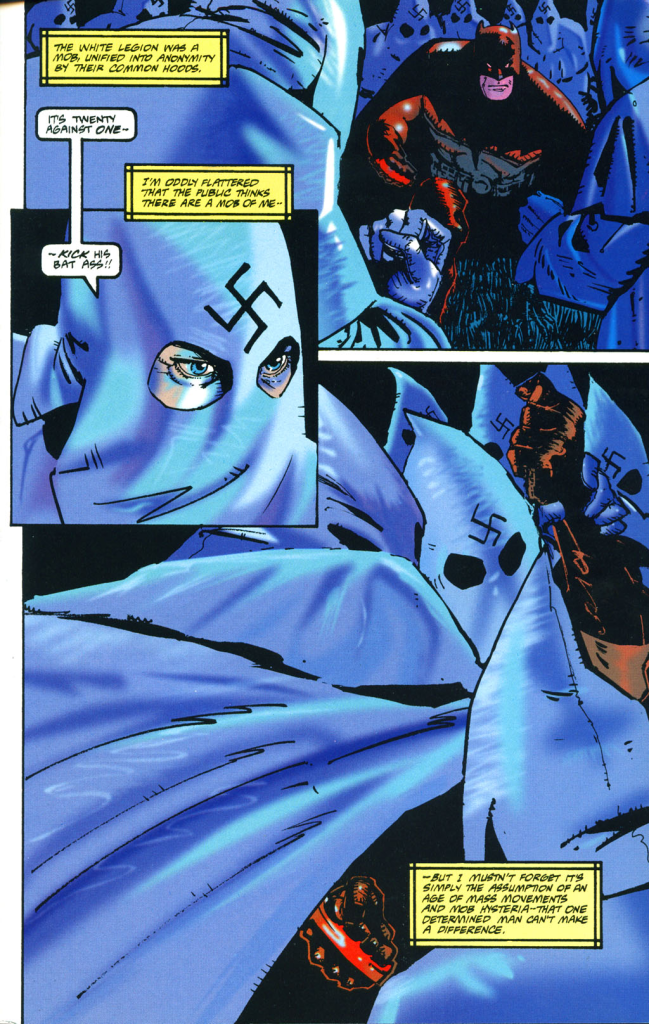 Dark Allegiances
Dark Allegiances
Likewise, the movies are a whole other universe. Christopher Nolan’s trilogy seems to endorse mass secret surveillance as well as police hordes gleefully marching with their batons in the air to beat up civilians – which of course no democratic government would ever support, right? Anyway, it’s not as if anything in The Dark Knight Rises really makes sense.
In the regular comics, Batman is less of an Übermensch than a Renaissance Man, powered not by genes but by training and study. He does believe in instilling fear, although not of the state but specifically of Batman (what the Scarecrow once called ‘chiropter-homophobia’), and sees himself as a crime-fighter rather than a ruler. The Caped Crusader is also more of a Gothamist than a nationalist. And he does not advocate genocide or anti-Semitism… in fact, he doesn’t discriminate, beating up thugs from any ethnic background:
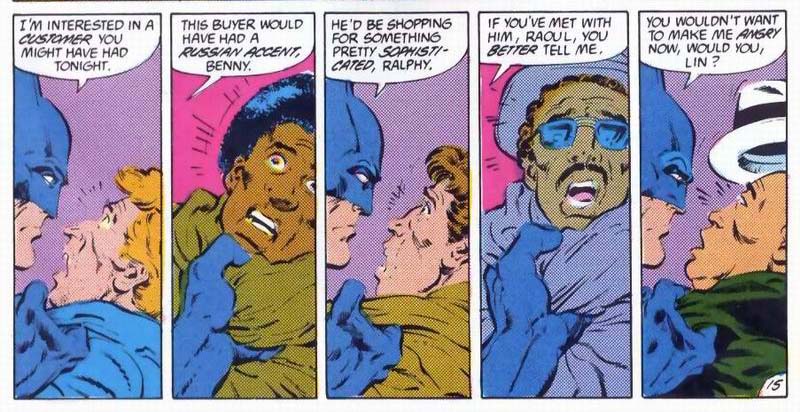 Batman #418
Batman #418
What’s more, Batman has kicked more Nazi butt than Indiana Jones! Sure, he didn’t personally punch Adolf Hitler during World War II, like Superman or Captain America did, but in 1942 the Dark Knight took care of a network of Nazi spies operating in the US.
That story, published in Batman #14 (cover-dated December 1942-January 1943), starts off with the saga of Fred Hopper, a young wide-eyed amateur movie photographer trying to break in as a newsreel cameraman. Just to get rid of the annoying wannabe, an editor sets him up with the almost impossible task of getting shots of a reclusive multimillionaire, but Fred succeeds when a couple of veteran cameramen help him infiltrate the millionaire’s home. It’s an old-fashioned paparazzo success story! Except there’s a catch: Fred Hopper is actually called Fritz Hoffner and he is a member of a spy ring whose headquarters even have a swastika-shaped lamp:
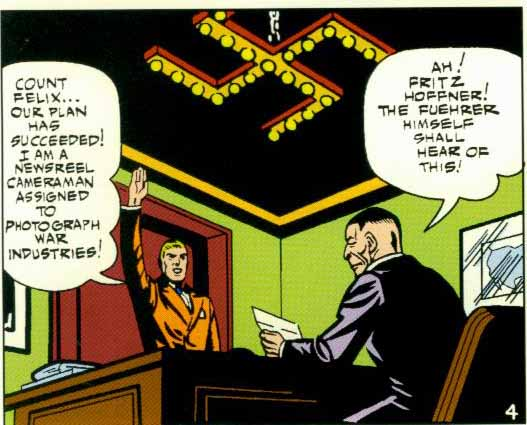 Fearing that Batman could get in the way of the Nazi plot to sabotage America’s war effort, the spies decide to kill the Caped Crusader. Conveniently, Fred is soon tasked by the Gotham City Newsreel Company with filming a publicity stunt the Dynamic Duo is doing for the war bond campaign, but the assassination attempt fails. Later, Batman and Robin barely make it out alive when they try to prevent the spies from blowing up storage tanks for the gasoline that takes American bombers across the ocean. The whole thing culminates with a showdown at the Nazi headquarters, where the Dark Knight puts the weird lamp to good use:
Fearing that Batman could get in the way of the Nazi plot to sabotage America’s war effort, the spies decide to kill the Caped Crusader. Conveniently, Fred is soon tasked by the Gotham City Newsreel Company with filming a publicity stunt the Dynamic Duo is doing for the war bond campaign, but the assassination attempt fails. Later, Batman and Robin barely make it out alive when they try to prevent the spies from blowing up storage tanks for the gasoline that takes American bombers across the ocean. The whole thing culminates with a showdown at the Nazi headquarters, where the Dark Knight puts the weird lamp to good use:
 Yep, in a non-too-subtle ironic twist, that swastika-lamp totally saves the day:
Yep, in a non-too-subtle ironic twist, that swastika-lamp totally saves the day:
 Decades later, in the awesome ‘The Angel, the Rock and the Cowl!’ (The Brave and the Bold #84), Bob Haney retroactively establishes that Bruce Wayne was in France just before D-Day, following secret instructions from Winston Churchill himself. There is some Notorious in there, but mostly that comic feels like a balls-to-the-wall war movie in the style of Kelly’s Heroes, Secret Invasion, and Where Eagles Dare, not to mention Inglourious Basterds. And it is only one of many instances in which Batman fought Nazis and neo-Nazis in the pages of The Brave and the Bold…
Decades later, in the awesome ‘The Angel, the Rock and the Cowl!’ (The Brave and the Bold #84), Bob Haney retroactively establishes that Bruce Wayne was in France just before D-Day, following secret instructions from Winston Churchill himself. There is some Notorious in there, but mostly that comic feels like a balls-to-the-wall war movie in the style of Kelly’s Heroes, Secret Invasion, and Where Eagles Dare, not to mention Inglourious Basterds. And it is only one of many instances in which Batman fought Nazis and neo-Nazis in the pages of The Brave and the Bold…
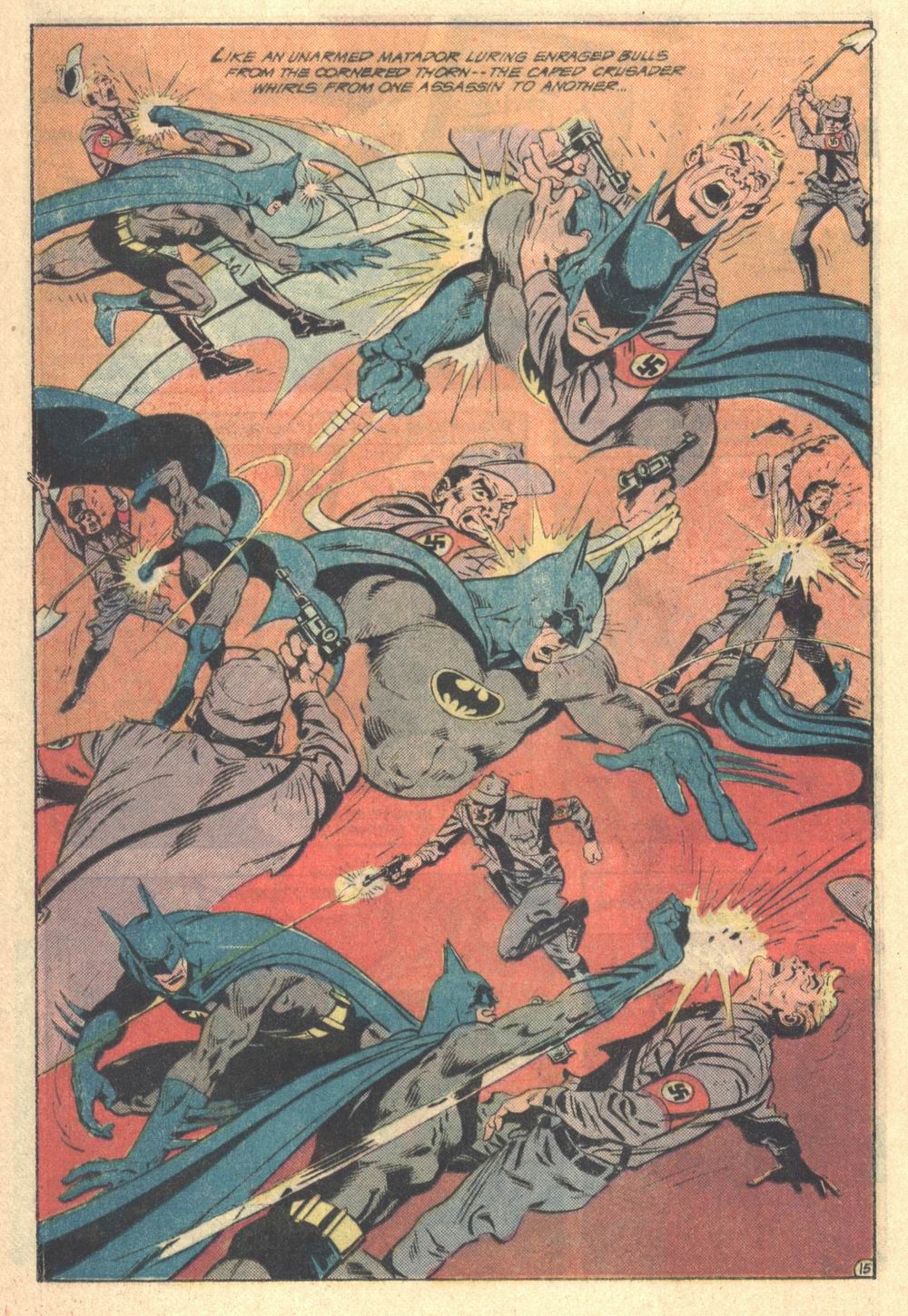 The Brave and the Bold #188
The Brave and the Bold #188
Seriously, poor Jim Aparo is responsible for more images of Nazis than Leni Riefenstahl!
By the 1990s, writers were clearly struggling to innovate. You could read about Batman fighting Nazi zombies (Legends of the Dark Knight Annual #1) and Nazi demons (Hitman #3).
As far as threats from the past go, it’s safe to say that there is only one kind of villain that seems to get Batman giddier to fight than Nazis…
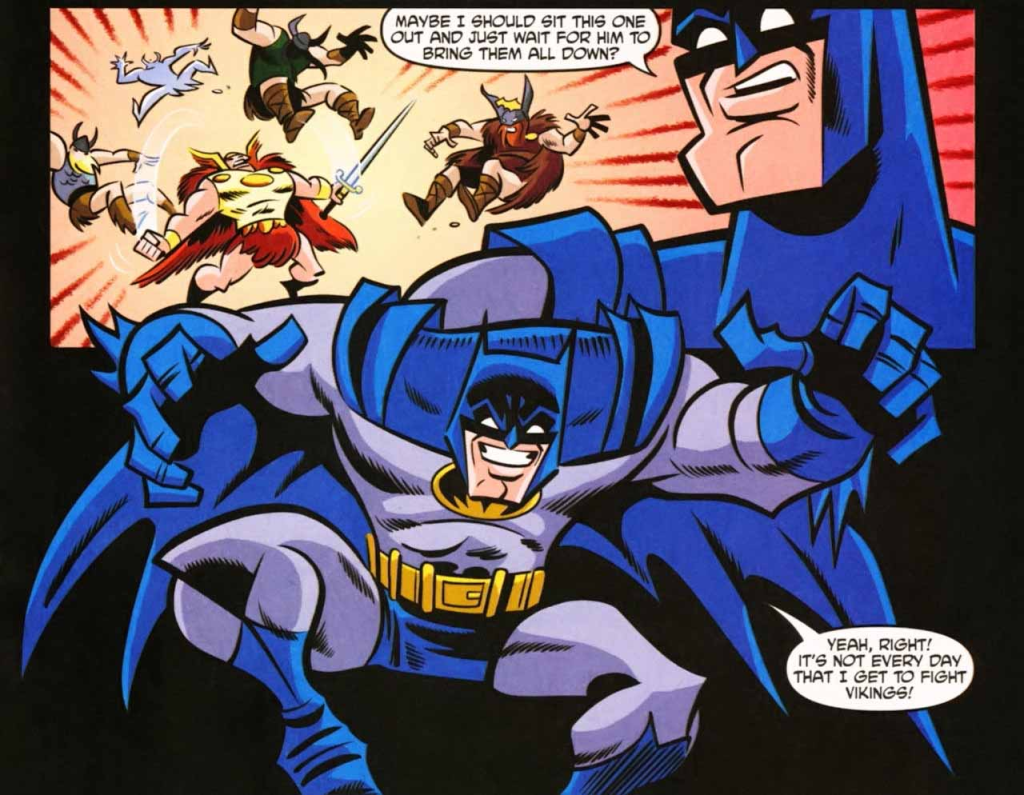 Batman: The Brave and the Bold #6
Batman: The Brave and the Bold #6
NEXT: Batman gets shot. A lot.


